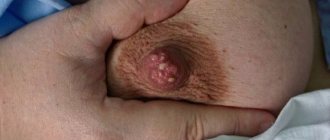Appearance
Mammary glands are present not only in women, but also in men. The anatomy of the female mammary gland is initially completely identical to the male anatomy, since the mammary glands are formed in both sexes during prenatal development.
Before puberty, the difference is completely unnoticeable, and only during the period of hormonal changes do the size, shape and structure of the female breast change.
Form
The mammary glands in women look like two symmetrical convex hemispheres. The location of the mammary glands in women is at the level of the third to sixth pair of ribs. Just below the center of the roundness is the nipple, surrounded by the areola.
There is also a generally accepted classification of breasts depending on their shape:
- discoid - a small gland with a wide base;
- hemispherical - diameter and height are approximately equal;
- pear-shaped – the height significantly exceeds the base;
- mastoid - similar in parameters to the pyriform, but the gland itself is more strongly lowered, the nipples are located lower and directed downwards.
Size
You cannot take any specific size as the norm, since it develops individually for each woman.
The average is considered to be a girth of 80 to 85 cm. A slight asymmetry, when one gland is slightly larger, can be considered normal.
The size of the mammary glands depends on several factors:
- amount of adipose tissue:
- the size of the gland itself;
- full of milk.
The weight of the mammary gland in a nulliparous girl is on average 200 g; during breastfeeding it can reach 800-900 g. After the end of lactation, the gland decreases in size. Size does not affect the amount of milk and the possibility of lactation.
The hormonal background of the female body affects the size of the mammary gland; its appearance can change depending on the phase of the menstrual cycle and change with age.
Nipples
The areola (a pigmented round area of skin with a diameter of 3-5 cm) is located slightly below the middle of the breast gland, approximately at the level between the fourth and fifth pair of ribs. In its center there is a nipple, which has a flat-cylindrical or cone-shaped shape. The color of the areola and nipple varies from light pink in nulliparous and fair-skinned women to dark brown or brown in parous women or in women with darker skin. In nursing women with a large bust, the diameter of the areola can exceed 10 cm, and the pigmentation of the areolar-nipple area becomes more intense during this period.
The structure of the nipple: the milk ducts come out and form the nipple, around which the areola is located. Under the skin of the areola are 10 to 15 vestigial areolar glands and a small number of sebaceous and sweat glands. There are small holes on the surface of the nipple, which are the exit of the milk ducts, through which milk flows.
The skin on the nipples and areola is very thin and covered with small folds that resemble wrinkles.
Bundles of smooth muscle cells located on the areola and nipple contract when exposed to cold or touch, causing the nipple to shrink and slightly increase in size.
Internal structure
What are women's breasts made of? The structure of the mammary gland in a mature woman consists of the body of the mammary gland itself, adipose and connective tissue. The size of the breast and its shape depend on the amount of fatty tissue. Changes in a woman's weight will certainly affect her bust size.
Glandular and adipose tissue
The body of the mammary gland consists of 15-20 individual hollow cones. The structure of the female mammary gland resembles a grapevine with an abundance of grapes, since the lobes are divided into small lobes by layers of fatty and loose connective tissue. The lobules consist of alveoli, a kind of bubbles that produce milk. The structure of the female breast can be felt by palpation; it consists of small bumps or nodules. The lobes are arranged in a circle, their tops directed towards the nipple.
The gland is surrounded by adipose tissue, which protects the gland from external influences. The fat layer helps maintain a certain temperature necessary for milk production, and it also contains nutrients necessary during pregnancy and lactation.
The ratio of adipose and glandular tissue is individual for each woman.
The size of glandular tissue is influenced by hormonal levels, which is especially noticeable by changes in breast size at different periods of the menstrual cycle. The amount of glandular tissue increases during lactation, and upon completion of feeding, part of the glandular tissue is converted into intraglandular fat.
In young girls, glandular tissue predominates in the structure of the breast, so the bust of young girls is more elastic.
Channels
Milk ducts extend from the tops of the lobes, which extend to the end of the nipple (milk pores), and in front of the mouth they expand, forming milk sinuses, where breast milk accumulates.
Blood supply
Three large arterial vessels are responsible for the blood supply to the mammary gland:
- branches of the internal mammary artery;
- lateral thoracic artery;
- medial thoracic artery.
Nerves, lymph nodes
The connection between the mammary gland and the central nervous system is carried out mainly through branches of the intercostal and supraclavicular nerves. The nerve plexuses reach their greatest density in the areola-nipple region. Since the nerve endings are located close to the surface, this part of the mammary gland is one of the most sensitive erogenous zones.
The structure of a woman's mammary gland is quite complex, especially with regard to the lymphatic system. Due to the anatomical features, the breasts are quite mobile, this is also reflected in the structure of the lymphatic system of this part of the body. The paramammary system is the main group of lymph nodes that are located on the pectoralis major muscle.
Muscles
The structure of a woman's sternum consists of muscle tissue located around the mammary glands. The pectoralis minor and major muscles are located under the gland and fatty tissue. The serratus anterior muscle runs around them, the biceps brachii muscle runs nearby and part of the latissimus dorsi muscle is located, supporting the bust from the side and from above. A small amount of muscle is located in the nipple. There are no muscles in the mammary gland itself.
Anatomy of the Human Breast - information:
Breasts , or mammary glands, are a distinctive feature of representatives of the class mammals.
In humans, both women and men have mammary glands. They are identical in structure, differing only in the degree of development. Before puberty, the breasts of girls and boys are no different. With some endocrine system disorders, mature men may experience breast enlargement (gynecomastia) and milk secretion. The mammary gland of newborns is also able to produce secretion (the so-called milk of newborns, Latin lac neonatorum), but this is not a physiological norm.
In a mature woman, the breasts are formed by two symmetrical hemispherical elevations adjacent to the anterior chest wall in the area between the third and sixth or seventh ribs. For the most part of its base, each gland is attached to the pectoralis major muscle (lat. m. pectoralis major) and partly to the anterior serratus muscle (lat. m. serratus anterior). On the outer side between the breasts there is a depression called the sinus (lat. sinus mammarum).
Slightly below the middle of each breast, approximately at the level of the fourth intercostal space or fifth rib, there is a small protrusion on the surface - the breast nipple (lat. papilla mammae). As a rule, in women who have not given birth, the nipple has a cone-shaped shape, while in women who have given birth, it is cylindrical. It is surrounded by the so-called areola (lat. areola mammae) with a diameter of 3-5 cm. The pigmentation of the skin of the nipple and areola differs from the rest of the skin - it is noticeably darker. In nulliparous women it is pinkish or dark red, in women who have given birth it is brownish. During pregnancy, the intensity of pigmentation increases.
During sexual arousal, as well as during the ovulation phase, an increase in nipple erectility and sensitivity is observed. The erection of the nipple is caused by the contraction of the muscle fibers located inside it, and, unlike the erection of the clitoris, is not associated with blood circulation. In the areola there are a number of small rudimentary mammary glands, the so-called Montgomery glands (lat. glandulae Montgomerii), forming small elevations around the nipple. The skin of the nipple is covered with fine wrinkles. At the top of the nipple there are small openings - milk pores (lat. pori lactiferi), which are the ends of the milk ducts (lat. ducti lactiferi) coming from the tops of the milk lobes (lat. lobi mammae). The diameter of the milk ducts is from 1.7 to 2.3 mm. Some milk ducts merge with each other, so the number of milk openings is always less than the number of ducts (usually there are from 8 to 15). The mammary gland itself (lat. glandula mammaria), which forms the basis of the female breast and is also called the body of the mammary gland (lat. corpus mammae), is a dense body in the shape of a convex disk, surrounded by a layer of fat (lat. capsula adiposa mammae).
The body of the mammary gland consists of 15-20 separate cone-shaped lobes, located radially around the breast nipple, with their apex facing it and separated from each other by layers of connective tissue. Each lobe, in turn, consists of larger and smaller lobules (lat. lobuli mammae). Each lobule consists of alveoli with a diameter of 0.05-0.07 mm. The blood supply to the mammary glands is carried out mainly by the internal thoracic (lat. a. mammaria interna) and lateral thoracic (lat. a. thoracalis lateralis) arteries.
Breast size and shape
Breast size and shape vary from person to person. The mammary gland itself is much smaller in size than the entire breast. Individual differences in the size of female breasts are determined by the thickness of the subcutaneous fat layer. The shape of the breast (erect or pendulous) depends on the strength and elasticity of the connective tissue capsule in which the mammary gland is enclosed.
Thus, neither the size nor shape of the breast affects a woman's ability to breastfeed. However, they are an important component of sexual attractiveness. Breast size is usually expressed in terms applied to bra sizes. The average breast size fluctuates around 80 cm in girth. Usually the left breast is slightly larger than the right.
Breast changes during pregnancy and lactation
During the menstrual cycle, the mammary gland is subject to cyclic changes, but the greatest changes occur during pregnancy. The mammary gland usually has an average diameter of 10-12 cm and a thickness of 2-3 cm. The weight of the gland in young nulliparous women ranges from 150-200 g. Already in the second month of pregnancy, visible changes are observed. The peripapillary circle enlarges and becomes darker. Changes also occur inside the gland itself; right up to the moment of birth, the gland gradually increases in size and is internally rebuilt. During lactation, the weight of the mammary gland increases to 300-900 g. During pregnancy, the gland gradually begins to secrete the so-called colostrum (lat. colostrum gravidarum), which gradually changes its properties as pregnancy progresses and becomes more and more similar to milk.
In the first days after birth, the so-called transitional milk (lat. colostrum puerperarum) is released, which, as a rule, is thicker and yellower than regular breast milk. Normal mature human milk (lat. lac femininum) is a pure white or bluish-white odorless liquid with a faint sweetish taste, fat content is about 4%. Human milk also contains salts and trace elements necessary for the healthy growth of the newborn. At the end of the lactation period, the iron decreases again, but usually does not reach its original (pre-pregnancy) size.
Breasts in men
Male breasts (Latin: mamma virilis) have fundamentally the same structure as female breasts, but with normal hormonal balance in the body they do not develop. The breast nipple (lat. papilla mammae) and the areola (lat. areola) are much smaller than in women. The nipple protrudes above the surface of the breast by only 2-5 mm. The position of the nipples relative to the vertical may vary. Usually the nipple is located at the height of the fifth rib, less often - between the fourth and fifth intercostal spaces. In an adult male, the body of the gland reaches approximately 1.5 cm in width and 0.5 cm in thickness. The lobules and ducts are almost undeveloped. If there are hormonal imbalances, breast enlargement (gynecomastia) may occur. Sometimes there are cases of polythelia.
How hormones affect breast development
The structure of the breasts in women directly depends on the level of hormones. The entire cycle of breast development, from puberty to menopause, is influenced by about 15 hormones.
Let's look at the most important ones:
- Estrogens – stimulates the growth of connective tissue cells and the development of mammary glands.
- Progesterone - increases the number of alveolar cells, affects the growth of glandular tissue.
- Prolactin causes the division and growth of new epithelial cells. It has a very important role during lactation, ensuring the fullness of milk.
- Insulin - stimulates the growth of new cells caused by the action of prolactin, glucocorticoids and progesterone.
Changes
All changes in the female breast are directly related to changes in hormonal levels.
Puberty
Before the onset of puberty, the mammary glands consist of a small number of lobes, connective and fatty tissue, and are in an underdeveloped state. During puberty, branching and growth of the milk ducts occurs, as well as the proliferation of adipose tissue.
Birth of a child
Intensive growth of glandular tissue with branching and elongation of ducts, development of alveoli, production and accumulation of milk in them, intensive growth of glandular tissue lead to a significant increase in the bust during pregnancy and lactation.
After breastfeeding ends, breast size decreases due to a reduction in secretory sections. When the next pregnancy occurs, the entire cycle repeats again.
Menopause
During menopause, the reverse development of the mammary glands begins - senile involution. The body of the gland disappears, and only connective fibers and adipose tissue remain.
Anomalies
There are breast anatomy with congenital or acquired pathology.
Macromastia is a pathological increase in the size of the mammary gland that occurs after disruption of the endocrine system during pregnancy or puberty.
Polymastia - a malfunction during intrauterine development of the fetus leads to the appearance of additional mammary glands, which can be located on the chest and abdomen from the armpits to the groin area. With polymastia, there is a high chance of developing oncology, so it is recommended to remove its manifestations.
Polythelia is a congenital genetic pathology expressed by an increased number of nipples located along the mamillary lines of the body. Accessory nipples are often mistaken for moles. This anomaly can occur in both women and men.
Amastia is a rare abnormality in which one or both mammary glands fail to develop. This pathology can be found in infants of both sexes. It does not pose a threat to life, but if the pathology is detected in a girl, then breastfeeding will be impossible for her in the future.
A flat or inverted nipple in a woman is not a pathology, but it does cause some inconvenience during breastfeeding. A small plastic surgery will help correct the shape of the nipples.
Unusual phenomena
The nipple can be double, with the normal nature of the gland itself. This is the case when the third mamma
.
It is necessary to distinguish from this those conditions when the nipples and, probably, also the glands corresponding to them develop in two symmetrical longitudinal rows. Under the normal mamma
, there may be one extra one on each side, but there are also several such additional formations (
mammae accessoriae
).
In extreme cases, eight additional nipples are observed, of which three are located above the developed mamma, and two below it. All primates have only one pair of glands. Thus, the appearance of additional nipples is adjacent to the condition that we find in prosimians, etc. See Wiedersheim, Bau des Menschen.
4 Aufl. , 1908. Fig. 12-18.
| Fig. 63. Hypermastia in a 22-year-old girl From Wiedersheim. (According to Neugebaur). | |
Above we have already mentioned the Montgomery glands as intermediate forms between the ordinary sebaceous and mammary glands. Those cases where mammary glands appear in unusual places are quite in accordance with the morphological relationship of both groups of alveolar glands. Such heterotypic mammary glands were observed on the shoulder, in the armpit, on the thigh, etc. Without a doubt, we are dealing here, to a certain extent, with displacements, but still in all cases there was a morphological basis on the face in the form of sebaceous ( or sweat glands.
Care
The female breast is a very important and very sensitive organ of the reproductive system, requiring careful care and special attention.
Please note the following helpful care tips:
- Regular hygiene procedures, especially important during breastfeeding, will help maintain breast health. To care for breast skin, you should choose natural-based cosmetics without overusing hormonal products.
- Contrasting rubdowns and air baths have a beneficial effect on the condition of the breast.
- The bra should be selected according to size, giving preference to products made from natural fabrics, with flat seams, without protruding underwires.
- The chest should be protected even from minor injuries. The most minor damage can lead to malignant formations in the future.
- Regular self-examination and visits to a mammologist will help monitor breast health and detect the disease at an early stage.
Proper breast care and timely examinations will help you maintain beauty and health for many years.
Breast diseases
Mammalogy
- an independent branch of medicine that studies the structure of a woman’s mammary glands, the physiological processes occurring in them, as well as the prevention and treatment of emerging breast diseases. Mammology is interconnected with other medical disciplines that study the woman’s body: gynecology, endocrinology, as well as surgery and oncology. Breast diseases can occur in women at different ages. The most dangerous age for breast cancer is considered to be over 40 years of age. During this period, women need to regularly self-monitor their breasts, undergo an X-ray examination and ultrasound.
A woman's mammary glands are paired exocrine glands. Their main function in the female body is lactation, that is, milk production, which ensures feeding of the infant. Therefore, the mammary glands are also called mammary glands.
Like no other organ, the mammary glands are influenced by all the processes occurring in the female body: the menstrual cycle, pregnancy, lactation, menopause - the breast reacts to all this with its anatomical and physiological changes.
Despite the fact that most of a woman’s life the mammary glands are “at rest,” but as a hormone-dependent organ, they undergo complex changes due to the physiology of the female body. And the occurrence of most breast diseases is associated precisely with hormonal imbalances.
Thus, with endocrine disorders, benign formations can occur in the mammary gland - mastopathy, cyst and fibroma of the mammary gland. Their development is often associated with abortion, as well as inflammatory diseases of the female reproductive organs, disrupting the hormonal function of the ovaries and other endocrine glands.
Diseases of the mammary gland leading to its inflammation - mastitis, develop, as a rule, during breastfeeding: these are lactostasis and nipple cracks.
Of particular concern to breast oncologists is the increase in the number of malignant tumors (breast cancer). Their development is predisposed by trauma and inflammatory diseases of the breast, abortion, sexually transmitted infections, late (after 35 years) first pregnancy and childbirth, endocrine disorders, bad habits, ecology and heredity.
An important role in the prevention of breast diseases is played by timely treatment of genital pathology, personal hygiene and breastfeeding rules, self-control, and regular visits to specialists: a gynecologist and mammologist.
Every woman should carefully examine her mammary glands every month on days 6-12 of the menstrual cycle. If you notice the first warning symptoms, you must urgently consult a mammologist.
A particular mammological disease may be indicated by the appearance of at least one of the following complaints in a woman: lumpiness, tenderness in the breasts, the appearance of discharge from the nipples, changes in the skin on the chest and in the nipple area, changes in the shape of the gland, enlarged lymph nodes in the axillary areas.
After 35 years, women need to undergo an ultrasound of the mammary glands once a year, and after 40, mammography once every 2 years. You should visit a mammologist if you are planning a pregnancy or taking oral contraceptives.
Today, most timely detected breast diseases are successfully treated conservatively. Surgical treatment of mammological pathology is aimed at the most careful preservation of the organ and its function.
The Medical Directory of Diseases describes in detail the main diseases of the mammary glands and describes methods of their diagnosis and treatment. This can help you independently assess the condition of your breasts and recognize the symptoms of an incipient disease in time.
Beautiful and healthy breasts are the pride of a woman, the envy of her friends and the object of men’s attention.
On the Beauty and Medicine website you will always find useful information on how to keep your breasts healthy and attractive for many years. Further…











